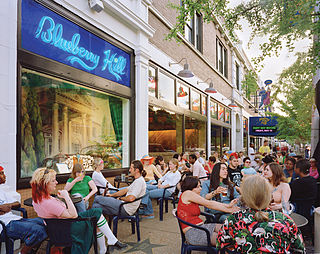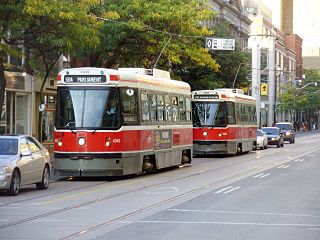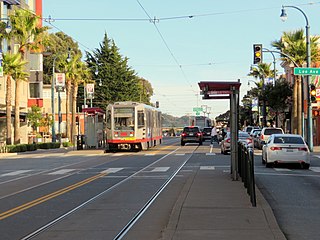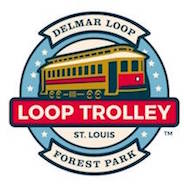
The Portland Streetcar is a streetcar system in Portland, Oregon, that opened in 2001 and serves areas surrounding downtown Portland. The 3.9-mile (6.3 km) NS Line runs from Northwest Portland to the South Waterfront via Downtown and the Pearl District. The Loop Service, which opened in September 2012 as the Central Loop, runs from Downtown to the Oregon Museum of Science and Industry via the Pearl District, the Broadway Bridge across Willamette River, the Lloyd District, and the Central Eastside Industrial District and added 3.3 miles (5.3 km) of route. In September 2015 the line was renamed as the Loop Service, with the A Loop traveling clockwise, and the B Loop traveling counterclockwise. The two-route system serves some 20,000 daily riders.

The Pacific Electric Railway Company, nicknamed the Red Cars, was a privately owned mass transit system in Southern California consisting of electrically powered streetcars, interurban cars, and buses and was the largest electric railway system in the world in the 1920s. Organized around the city centers of Los Angeles and San Bernardino, it connected cities in Los Angeles County, Orange County, San Bernardino County and Riverside County.

The Delmar Loop, often referred to by St. Louis residents simply as The Loop, is an entertainment, cultural and restaurant district in University City, Missouri and the adjoining western edge of St. Louis, Missouri. Many of its attractions are located in the streetcar suburb of University City, but the area is expanding eastward into the Skinker-Debaliviere Neighborhood of the City of St. Louis. In 2007, the American Planning Association named the Delmar Loop "One of the 10 Great Streets in America."

Streetcars in New Orleans, Louisiana have been an integral part of the city's public transportation network since the first half of the 19th century. The longest of New Orleans' streetcar lines, the St. Charles Avenue line, is the oldest continuously operating street railway system in the world. Today, the streetcars are operated by the New Orleans Regional Transit Authority (RTA).

The Waterfront Streetcar, officially the George Benson Waterfront Streetcar Line, was a heritage streetcar line run by King County Metro in Seattle, Washington, United States. It traveled for 1.6-mile (2.6 km) along Alaskan Way on the city's waterfront facing Elliott Bay. Service began on May 29, 1982, the first streetcars to run in Seattle since the closure of the Seattle Street Railway on April 13, 1941.
The St. Louis Car Company was a major United States manufacturer of railroad passenger cars, streetcars, trolleybuses and locomotives that existed from 1887 to 1974, based in St. Louis, Missouri.

The F Market & Wharves line is one of several light rail lines in San Francisco, California. Unlike most other lines in the system, the F line runs as a heritage streetcar service, almost exclusively using historic equipment both from San Francisco's retired fleet as well as from cities around the world. While the F line is operated by the San Francisco Municipal Railway (Muni), its operation is supported by Market Street Railway, a nonprofit organization of streetcar enthusiasts which raises funds and helps to restore vintage streetcars.

The K Ingleside is a Muni Metro line in San Francisco, California, mainly serving the West Portal and Ingleside neighborhoods. Opened on February 3, 1918, it was the first line to use the Twin Peaks Tunnel.

The San Diego Electric Railway (SDERy) was a mass transit system in Southern California, United States, using 600 volt DC streetcars and buses.

The Toronto streetcar system is a network of ten streetcar routes in Toronto, Ontario, Canada, operated by the Toronto Transit Commission (TTC). It is second busiest light-rail system in North America. The network is concentrated primarily in Downtown Toronto and in proximity to the city's waterfront. Much of the streetcar route network dates from the 19th century. Most of Toronto's streetcar routes operate on street trackage shared with vehicular traffic, and streetcars stop on demand at frequent stops like buses.

The Illinois Terminal Railroad Company, known as the Illinois Traction System until 1937, was a heavy duty interurban electric railroad with extensive passenger and freight business in central and southern Illinois from 1896 to 1982. When Depression era Illinois Traction was in financial distress and had to reorganize, the Illinois Terminal name was adopted to reflect the line's primary money making role as a freight interchange link to major steam railroads at its terminal ends, Peoria, Danville, and St. Louis. Interurban passenger service slowly was reduced, and it ended in 1956. Freight operation continued but was hobbled by tight street running in some towns requiring very sharp radius turns. In 1956, ITC was absorbed by a consortium of connecting railroads.

The McKinney Avenue Transit Authority (MATA), a non-profit organization, operates the M-line Trolley in Dallas, Texas (USA). The offices and car barn are located at 3153 Oak Grove, Dallas, TX 75204. In operation since 1989, it is an example of a heritage streetcar running historic cars. The main stretch of the line runs down McKinney Avenue in Uptown. While the "M-Line" name was officially adopted for the service in 2002, the line continues to be commonly known as "the McKinney Avenue trolley".

Electric streetcars or trolley(car)s were once the chief mode of public transit in hundreds of North American cities and towns. Most of the original urban streetcar systems were either dismantled in the mid-20th century or converted to other modes of operation, such as light rail. Today, only Toronto still operates a streetcar network essentially unchanged in layout and mode of operation.

Ocean and Lee is a light rail stop on the Muni Metro K Ingleside line, located between the Westwood Park and Ingleside neighborhoods of San Francisco, California. The stop consists of two side platforms, with the eastbound (outbound) platform located on Ocean Avenue west of the intersection with Lee Street, and vice versa. It originally opened in 1895 on the United Railroads 12 line; K Ingleside service began in 1945.

The Loop Trolley is a 2.2-mile (3.5 km), 10-station heritage streetcar line in St. Louis, Missouri. It runs between the Delmar Loop district and the Missouri History Museum in Forest Park, serving parts of University City and the St. Louis neighborhoods of DeBaliviere Place, Skinker/DeBaliviere, and the West End. It also serves two MetroLink light-rail stations: Delmar Loop and Forest Park–DeBaliviere. Two replica-historic streetcars run on Thursdays through Sundays. Service is planned to expand to seven days when a third streetcar arrives in 2019.

The Silver Line is a 2.7-mile (4.3 km) heritage streetcar light rail line operated by the San Diego Trolley, an operating division of the San Diego Metropolitan Transit System. It currently operates the "downtown loop"; a circle of tracks around Downtown San Diego, and is operated using renovated PCC streetcars. Service for the line currently only operates every 30 minutes on Tuesdays, Thursdays, weekends and select holidays during midday hours. It is officially named after San Diego Gas & Electric (SDG&E), which has provided grants to help restore at least one of the streetcars, as well as sponsoring a free educational program for third graders on the vintage line.



















